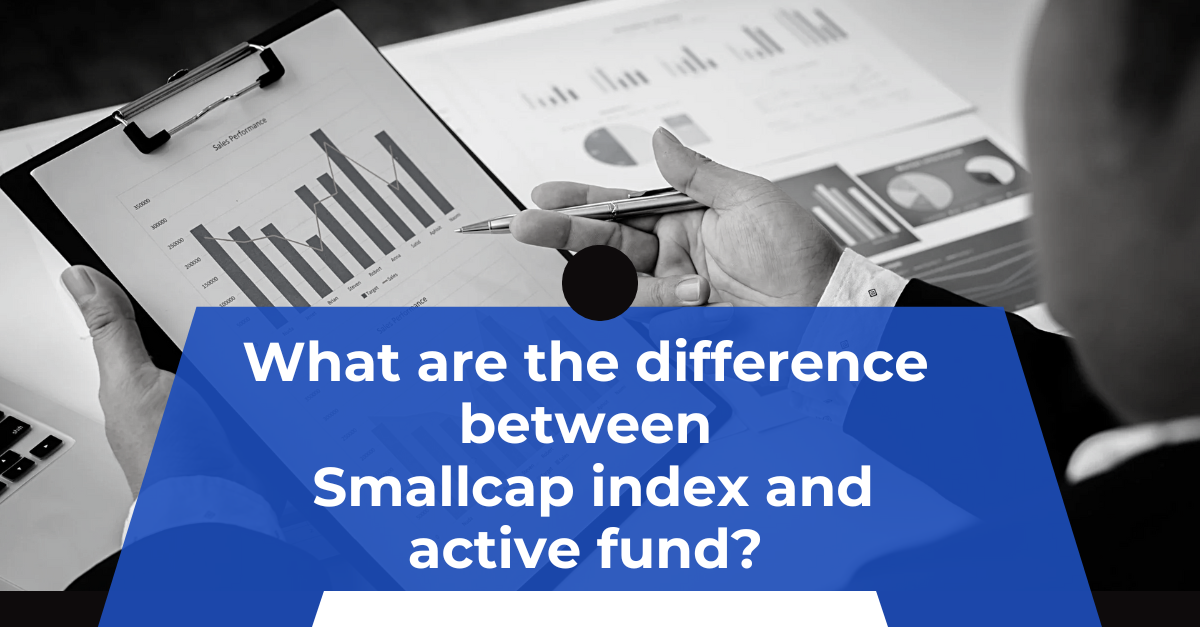The Smallcap index and active funds represent distinct approaches to investing, each with unique characteristics and benefits. The Smallcap index tracks the performance of small-cap companies, typically reflecting the overall health and trends within this segment of the market. It offers investors a passive investment strategy that mirrors the index’s performance, providing broad exposure to small-cap stocks with minimal management fees. In contrast, active funds are managed by professionals who make investment decisions with the goal of outperforming a benchmark index. These funds involve higher management fees and active selection of securities, aiming for superior returns based on market research and analysis.

Understanding the Smallcap Index
The Smallcap Index serves as a key benchmark for tracking the performance of small-cap companies, which are defined by their relatively lower market capitalization compared to their large-cap peers. This index is designed to provide investors with a snapshot of the performance and dynamics of smaller, potentially high-growth businesses in the stock market. It includes a broad selection of small-cap stocks, chosen based on market capitalization criteria, to offer a comprehensive view of the small-cap sector.
Key performance indicators for the Smallcap Index include total return, which encompasses both capital gains and dividends, and volatility measures, which evaluate the index’s price fluctuations. These metrics are essential for assessing the risk and return profile of small-cap investments, offering investors a benchmark to compare the effectiveness of small-cap-focused investment strategies. By reflecting the overall trends within this segment, the Smallcap Index helps investors make informed decisions about their small-cap investments.
Introduction to Active Funds
Active funds are investment vehicles managed by professional fund managers who seek to outperform a specific benchmark index through strategic security selection and market timing. Unlike passive funds, which aim to replicate the performance of an index, active funds involve a hands-on approach where managers actively make investment decisions based on research, market analysis, and economic forecasts. The primary objective of active funds is to achieve higher returns than the benchmark by leveraging expertise to identify undervalued securities and capitalize on market opportunities.
The management style of active funds is dynamic and flexible, allowing managers to adjust the portfolio in response to changing market conditions and economic trends. This proactive approach contrasts with passive strategies that maintain a static portfolio. By focusing on superior stock picking and tactical asset allocation, active funds aim to deliver enhanced performance and value for investors.
Key Differences Between Smallcap Index and Active Funds
| Aspect | Smallcap Index | Active Funds |
|---|---|---|
| Definition | A benchmark tracking the performance of small-cap stocks. | Investment funds managed by professionals aiming to outperform a benchmark. |
| Management Style | Passive, tracking the index with minimal management. | Active, involving hands-on management and decision-making. |
| Investment Strategy | Mimics the index’s performance by holding all or a representative sample of its components. | Selects securities based on research and market analysis to achieve higher returns. |
| Objective | To provide a benchmark for the performance of small-cap stocks. | To achieve superior returns compared to a benchmark index. |
| Fees | Generally lower, due to passive management. | Typically higher, due to active management and research costs. |
| Risk and Return | Reflects the inherent risk and return of the small-cap sector. | Aims for potentially higher returns but with increased risk due to active management. |
| Flexibility | Fixed, follows the index composition. | Flexible, adjusts portfolio based on market conditions and manager decisions. |
| Performance Measurement | Evaluated based on its ability to mirror the index’s performance. | Evaluated based on its ability to outperform the benchmark index. |
Cost Comparison: Smallcap Indices vs. Active Funds
When comparing costs between Smallcap Indices and Active Funds, notable differences emerge. Smallcap Indices typically incur lower fees due to their passive management style. These indices are designed to replicate the performance of small-cap stocks by holding all or a representative sample of the index’s components, requiring minimal management. Consequently, the expense ratios for index funds are usually lower, often ranging between 0.05% to 0.50%.
In contrast, Active Funds involve higher costs because of their hands-on management approach. Fund managers actively select and trade securities based on detailed research and market analysis, which requires substantial resources and expertise. This active management style leads to higher expense ratios, often between 0.75% to 2.00%, to cover research costs, manager salaries, and transaction fees. While active funds aim for superior returns, these higher costs can impact overall investment performance, making cost considerations crucial for investors.
Advantages and Disadvantages
Smallcap Indices
Pros:
- Cost Efficiency: Smallcap indices usually have lower expense ratios due to passive management, which minimizes investment costs.
- Diversification: They offer broad exposure to various small-cap stocks, diversifying risk across numerous companies.
- Transparency: The performance of the index is straightforward to track, as it mirrors a specific set of small-cap stocks.
Cons:
- Limited Flexibility: The index composition remains static and cannot adapt to changing market conditions.
- Market Exposure: Small-cap stocks can be more volatile, potentially leading to increased risk.
- No Outperformance Potential: The objective is to replicate, not exceed, the performance of the index.
Active Funds
Pros:
- Potential for Higher Returns: Skilled managers can leverage market inefficiencies and identify undervalued stocks for potentially superior returns.
- Flexibility: Managers can adjust portfolios based on market conditions, potentially reducing losses.
- Expertise: Professional managers provide in-depth analysis and decision-making to enhance performance.
Cons:
- Higher Costs: Active funds often have higher fees due to management and research expenses.
- Performance Variability: There is no guarantee of outperforming the benchmark, and performance can fluctuate.
- Increased Risk: Active management may involve higher turnover and risk, impacting overall stability.
Conclusion
In summary, the Smallcap Index and Active Funds offer distinct investment approaches. The Smallcap Index provides a cost-effective, passive strategy with broad exposure to small-cap stocks and transparent performance tracking, but lacks flexibility and the potential for outperformance. In contrast, Active Funds involve higher costs due to hands-on management but offer the potential for superior returns through expert stock selection and flexible portfolio adjustments. While Active Funds aim to outperform benchmarks, they come with increased risk and variability in performance. Investors must weigh these differences based on their investment goals, risk tolerance, and cost considerations.
Frequently Asked Questions (FAQs)
1. What is the main difference between a Smallcap Index and an Active Fund?
A Smallcap Index is a passive investment that tracks the performance of small-cap stocks with low management fees and fixed composition. An Active Fund, on the other hand, involves hands-on management aimed at outperforming a benchmark, often resulting in higher fees and greater flexibility.
2. Are Smallcap Indices less risky than Active Funds?
Smallcap Indices generally offer broad exposure to small-cap stocks, which can be volatile and risky. Active Funds can potentially manage risk better through strategic adjustments, but they also come with increased risk due to active management and higher turnover.
3. Which investment option is better for long-term growth?
For long-term growth, Smallcap Indices provide a cost-effective, diversified approach with steady performance tracking. Active Funds may offer higher return potential through expert management but come with higher costs and variability. The choice depends on individual investment goals and risk tolerance.
Read More:
- Mutual Funds and Taxes: How Income Tax Slabs Affect Your Returns
- What are tax-free annuity exchanges?
- 13 tax-free incomes in India – every investor should know
- Tax Return Tips for Last-Minute Filers

Hello, I am Tanisha Kriplani, graduated in computer science from Delhi University. I am passionate about web content writing and have a strong interest in Data Analytics and Data Engineering.












